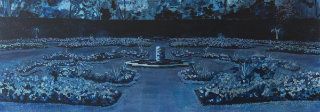

“I can’t do it justice.”
Our most vivid memories tend to elude capture. We try to share them with others, go Dutch on what was so meaningful to us—only to stammer in the recounting, repeating ourselves with different inflections and emphases, impotent in the face of the infinite.
Enter Robert Bingaman’s Memorial, new paintings that explore image, obsession, and the place where our compulsion to share outpaces our ability to describe.
Bingaman’s own photographs and experiences inspired many of these paintings. “Goff Pools” 1, 2, and 3 show us three distinct iterations of a hexagonal swimming pool in a Kansas City home designed by architect Bruce Goff.
On first encounter, the paintings look like natural extensions of the artist’s previous Pools series. Crisp edges cobwebbed in shadows. The vibrant shock of artificial light on artificial blue tile (this, the hallmark of pools: water itself is never sufficiently blue to appease our imaginations).
But new concerns and techniques are at play. The color palette, for one—in all three “Goff Pools,” the artist has swapped his subsuming black for a deep navy, one of the exhibition’s recurring shades. The rhythm, for another—although Bingaman has painted numerous pools over the past few years, these are the first repeated studies of the same pool.
The desire to capture one particular image and experience proved almost seductive for the artist. The pool was “too good to make just one painting of it,” he says. “I want to make as many as satisfy me.”
In “Goff Pool 2,” a clump of organic matter yawns in the foreground, another new motif. The organic matter provides a bridge to Memorial’s other paintings, some of which are set in European gardens.
That choice comes with baggage. Gardens have long been the subject of over-romantic landscapes and gold-toned scenes of cherubic nostalgia. But the pull (and purpose) of Bingaman’s gardens lies in the expressed tension between the infinite—the natural world in all of its genetic chaos—and human attempts to tame it into a more perfect symmetry, into something we can order and name.
The impulse is equal parts adoration and colonization. We prune a rosebush. We chlorinate water. We snap a photo of our vacation view, taking pains to compose the image in the most pleasing way.
It’s an act of hubris, but not without humor. “You go to the mountains.” Bingaman says. “You get your American transcendentalist experience standing at the cliff edge. And you think—‘you know what would be even better? If I made some of it.’”
Bingaman’s fascination with constructed spaces is sincere. He’s careful to point out that his paintings aren’t snide critiques. The privileged playthings they memorialize—gardens, tennis courts, pools—are optimized for our pleasure, at times hypnotically beautiful. His color choices reflect both the perceived and real richness of these spaces. A subtle shimmer of iridescent pearl creeps into pockets of each painting and warms them like a blush. A red snap of begonia blooms pulses through “Queen Mary’s Garden II,” the brilliance of the gesso underpainting beaming through to the top layer.
The images in Memorial remind us that the hyper-manipulation of the natural world can be as much an expression of devotion as arrogance. You’ve got to love the grass (or, at the very least, the people who lay in it) to seed and shear it with such meticulous care.
Subtle technical choices signal Bingaman’s participation in the same kind of obsessive image-making. In “Court 4 (Loose Park),” we see the neat lines of a tennis court suspended inches from the canvas edge. In “Normandy II,” a grin of white marks the bottom of an ersatz frame, the painter’s itch to pin his memory to a view. In every piece, a riff of hand-drawn grass—a nod to the imaginary figure who mowed it as much as the painter who painstakingly penned each blade.
The collective power of the individual strokes evokes Walt Whitman’s Leaves of Grass. We can look at these paintings and lose our balance, or assure ourselves that we, too, “contain multitudes”: a conqueror’s restless hunger, a scholar’s fastidious attention, an ingenue’s clumsy fingers and starry snowglobe eyes.
The obelisks and fountains that haunt Bingaman’s paintings give us a fixation point for our longing. Every painting a memorial, every image a way to possess some totem of our desire. We can’t do it justice. We know it’s not enough. We think this time it might be enough.
Liz Cook